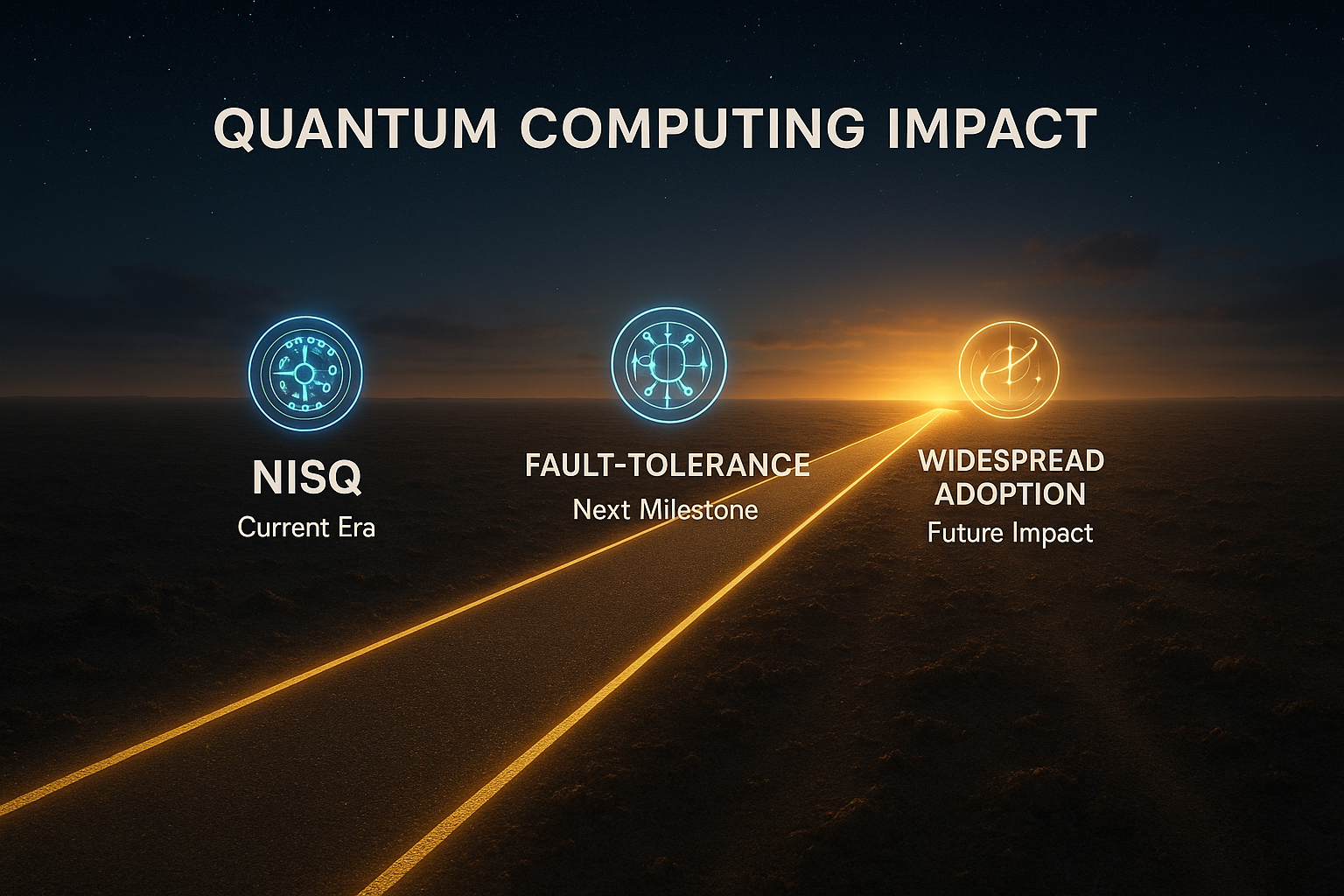Beyond the Buzz: Separating Fact from Fiction
'Quantum computing' is often shrouded in mystery and hype, promising to solve problems beyond our most powerful supercomputers and revolutionize fields from medicine to encryption. This report cuts through the noise to offer a clear, accessible explanation of what quantum computing truly is, its quantum computing capabilities today, and its realistic future.
Recognizing the "hype cycle" of emerging technologies, this analysis provides a balanced perspective, acknowledging both the immense potential and the significant, ongoing challenges in this revolutionary field.

Quantum vs. Classical: A Fundamental Shift
Traditional computers use "bits" (0 or 1). Quantum computers use "quantum bits" or qubits, which operate on principles of quantum mechanics.
Superposition and Entanglement
Superposition: Unlike a classical bit, a qubit can exist as a "weighted combination of zero and one at the same time." Imagine a spinning coin that is both heads and tails until measured. This allows quantum computers to explore numerous possibilities concurrently, boosting computational speeds for specific problems.
Entanglement: Qubits can become interconnected, meaning the state of one instantly influences another, regardless of distance. This "spooky action at a distance" enables complex interdependencies between data points, increasing efficiency far beyond classical limits.
When measured, a qubit's superposition "collapses" to either a 0 or a 1. While this parallelism allows exploration of vast solution spaces, quantum computers are specialized tools, excelling at specific problems, not simply processing all information faster. Classical computers remain superior for most everyday tasks due to their inherent stability.
The Decoherence Challenge
The very power of quantum computing—superposition and entanglement—is also its biggest hurdle. Qubits are "highly sensitive to environmental noise, temperature fluctuations, and electromagnetic interference," leading to "decoherence" (loss of their quantum state). This fragility makes quantum computers difficult and expensive to build, often requiring extreme conditions like cryogenic temperatures and complex error correction. Overcoming this is key to practical quantum computing capabilities.
Quantum's Real-World Impact Today
While still unfolding, quantum computing capabilities are actively addressing real-world problems by "fully controlling individual quantum systems."
Drug Discovery & Materials Science
Quantum computing can revolutionize drug development and materials design by simulating molecular interactions with unprecedented precision. Traditional methods struggle with molecular complexity. Quantum computers can model these intricate behaviors, accelerating drug discovery and designing new materials like advanced semiconductors, efficient solar cells, or better batteries. Companies like Pasqal, Qubit Pharmaceuticals, and IBM are actively using quantum approaches for protein analysis and molecular simulations. Microsoft's Azure Quantum Elements aims to condense 250 years of research into 25 years by integrating AI, HPC, and quantum.
Cybersecurity
Quantum computers pose a dual challenge and solution for cybersecurity. They can "render most of the world's existing encryption algorithms obsolete," but are also essential for developing quantum-safe encryption (post-quantum cryptography). Quantum Key Distribution (QKD) offers unhackable data transmission, and IBM is developing "quantum safe" solutions.
Optimization & AI
Quantum computers excel at complex optimization problems in logistics, supply chains, and finance by efficiently identifying optimal solutions (e.g., lowest costs, highest efficiencies). Early applications include optimizing clinical trials or drug pricing.
Integrating quantum computing with AI (Quantum AI or Quantum Machine Learning) promises capabilities beyond classical systems. Quantum algorithms enhance pattern recognition, data analysis, and optimization, improving accuracy in medical imaging, electronic health records, and natural language processing.
Recommended Channel: IBM Technology, Microsoft Azure, or World Science Festival
Direct Channel Links:
Breakthroughs and The Road Ahead
The quantum landscape is seeing rapid advancements in qubit stability, error reduction, and chip integration, moving towards practical utility.
Progress in Qubit Stability & Logical Qubits
Breakthroughs include cryogenic technologies enabling "millions of qubits on a single quantum processor" and custom CMOS chips operating at ultra-low temperatures without noise. Error rates have dropped dramatically (e.g., 0.000015% for single-qubit gates).
Industry focuses on logical qubits (error-resistant qubits encoded across multiple physical qubits). Google demonstrated a logical qubit prototype in 2023, showing error reduction. Microsoft and Quantinuum created 12 logical qubits in 2024. IBM aims for a fault-tolerant quantum computer with 200 logical qubits by 2029.
Industry Roadmaps
Major players have ambitious timelines:
- IBM: Large-scale, fault-tolerant quantum computer by 2029.
- Google: "Useful, error-corrected quantum computer" by 2029.
- Quantinuum: Universal, fault-tolerant quantum computing by 2030.
- Pasqal: Hardware-accelerated algorithms in production by 2025; 10,000-qubit system by 2026.
- IonQ: Broad quantum advantage by 2025.
Experts predict "interesting things" by 2029 (Mike Mayberry) and practical uses within five years (Bill Gates). Widespread mass use for governments and companies is likely in the 2030s, with consumer use by the late 2030s/early 2040s. The shift from "noisy intermediate-scale quantum" (NISQ) to "fault tolerance" is a critical, maturing transition.
Challenges to Widespread Adoption
Despite progress, significant technical and practical hurdles hinder widespread adoption of quantum computing capabilities.
Recommended Channel: Bloomberg Technology, TEDx Talks
Direct Channel Links:
Technical Hurdles:
- Quantum Decoherence: Qubits easily lose their quantum state from environmental disturbances, limiting "coherence time."
- Complex Error Correction: QEC is vital but difficult due to the "no-cloning theorem," requiring hundreds or thousands of physical qubits per logical qubit.
- Scalability Issues: Increasing qubit count while maintaining quality and interaction is a major engineering feat.
Practical Barriers:
- High Cost: Development and maintenance are "skyrocketing," with systems costing millions due to specialized components and extreme cooling.
- Scarcity of Talent: The field combines quantum theory, advanced math, and computer science, leading to a severe lack of skilled professionals.
- Complexity of Integration: Fitting quantum computing into existing IT infrastructure is a major hurdle.
- Need for Proven Use Cases: More widely adopted, compelling use cases demonstrating clear quantum advantage are still needed.
These technical and practical challenges are interconnected, with technical limitations directly impacting cost, talent availability, and the development of practical applications. Overcoming them requires significant engineering, investment, and talent development.
Realistic Timeline for Impact
It's crucial to distinguish "quantum advantage" (like Google's 2019 "quantum supremacy" demonstration) from widespread commercial utility. While supremacy proves theoretical power, practical utility requires fault tolerance, scalability, and algorithms that outperform classical methods.
Major players' roadmaps converge around 2029-2030 for achieving "fault-tolerant" or "useful, error-corrected" quantum computing. This indicates a maturing industry with a clear, strategically planned technological evolution.
The timeline suggests a phased approach: early applications (mid-2020s) for small optimization problems, transformative uses like in silico drug design later in the decade, widespread enterprise use in the 2030s, and consumer use even further out.
Preparing for the Quantum Revolution
The quantum revolution is an ongoing evolution demanding proactive engagement to unlock competitive advantages and mitigate risks.
For Industries
Quantum computing amplifies the competitive advantage of digitally mature organizations. Preparation involves:
- Building In-house Expertise: Invest in training, collaborate with universities to develop internal quantum teams.
- Making Targeted Investments: Fund quantum R&D, infrastructure for integration, and post-quantum cryptography. Support startups and intellectual property.
- Fostering Collaborations: Engage with the quantum ecosystem through partnerships to accelerate development and shape standards.
- Developing a Quantum Roadmap: Create a strategic plan to leverage quantum advancements for optimization, growth, and new revenue.
- Addressing Cybersecurity: Proactively implement "quantum-safe" solutions to protect data from future attacks.
For Individuals
The scarcity of quantum talent highlights the crucial role of individual learning and development.
- Understanding Fundamental Concepts: Learn basics of linear algebra and quantum mechanics.
- Exploring Educational Resources: Engage with programs like MIT xPRO's Quantum Computing Fundamentals. Platforms like IBM Quantum and Microsoft Azure Quantum offer free access and resources.
- Recognizing Career Opportunities: High demand exists for interdisciplinary skills combining quantum theory, math, and computer science.
- Considering Investment Opportunities: Explore major tech companies with quantum divisions or specialized ETFs (high-risk, no guarantees).
Conclusion: Embracing the Quantum Future
Quantum computing capabilities, leveraging superposition and entanglement, are poised to tackle currently intractable problems, from drug discovery and materials science to cybersecurity and AI. While the journey to fault-tolerant quantum computers is multi-decade, rapid breakthroughs and clear roadmaps signal an inevitable, gradual quantum future.
Ethical considerations are vital, with companies like IBM defining principles for "responsible development." To harness this shift, we must "cut the hype and focus on responsible development," through continuous learning, strategic investment, and collaboration. The long-term vision is clear: quantum computing holds the potential to significantly improve lives and revolutionize multiple industries.
What are your thoughts on the real-world quantum computing capabilities and its future impact? Share your perspective in the comments below!
Stay updated on the latest in technology and AI!


It’s excellent Information by ONPASSIVE AI BLOG SPOT.